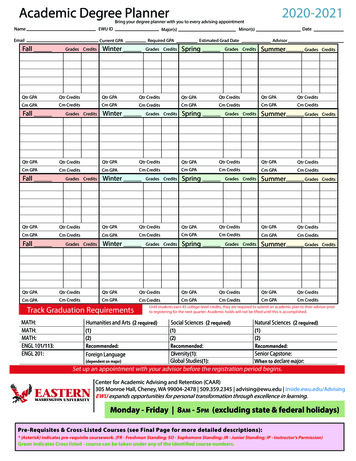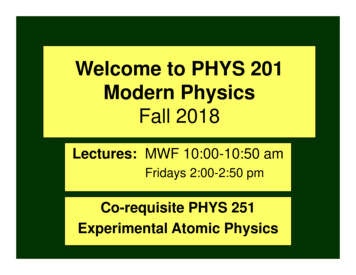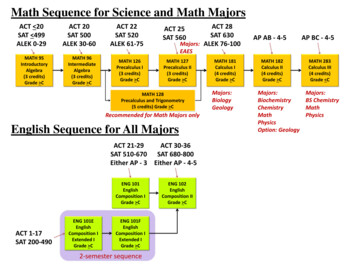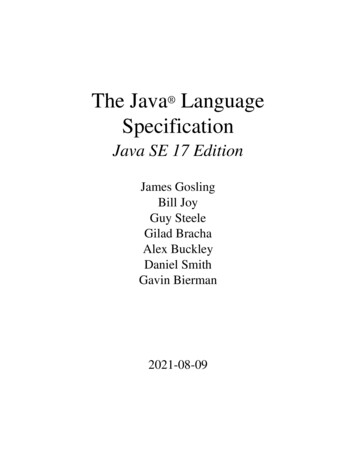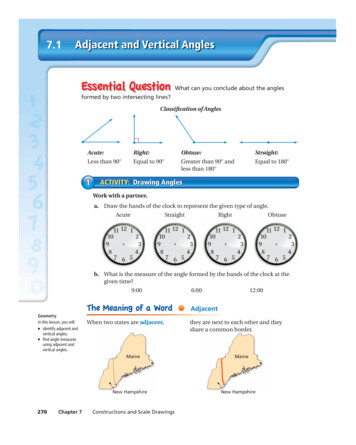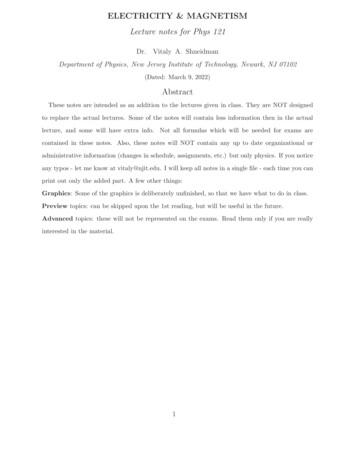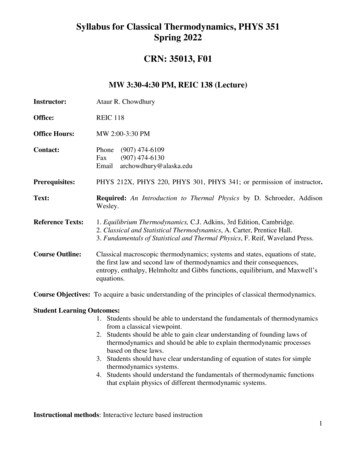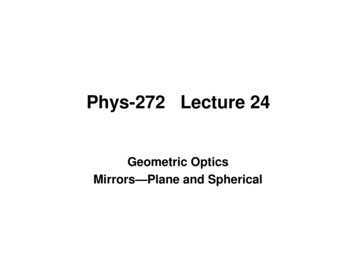
Transcription
Phys-272 Lecture 24Geometric OpticsMirrors—Plane and Spherical
Hubble Space Telescope
Plane (Flat) MirrorsAlready know physics:θR θISource: Object – emits raysin all directions.Eye intercepts cone of rays.
Plane MirrorsSIGN RULE convention for s and s′; IF object & incoming ray same side, s pos., otherwise neg. IF image & outgoing ray same side, s′ pos., otherwise neg. IF curvature center & outgoing ray on same side, pos.,otherwise neg.For mirror example, we have s -s′
Plane Mirrors
Flat Mirror(1) Draw first ray perpendicular to mirror 0 θi θr(2) Draw second ray at angle. θi θr(3) Lines appear to intersect a distance d behindmirror. This is the image location.Virtual Image:No light actually gets hereθrθidd
ClickerA woman is looking at her reflection in a flat vertical mirror.The lowest part of her body she can see is her knee.If she stands closer to the mirror, what will be the lowest part ofher reflection she can see in the mirror.A. Above her kneeB. Her kneeC. Below her kneeCD
ClickerA woman is looking at her reflection in a flat vertical mirror. The lowestpart of her body she can see is her knee. If she stands closer to the mirror,what will be the lowest part of her reflection she can see in the mirror.A. Above her kneeB. Her kneeC. Below her kneeIf the light doesn’t get to youreye then you cant see it
Concave MirrorsConcave: Consider the case where the shape of the mirror is suchthat light rays parallel to the axis of the mirror are all “focused”to a common spot a distance f in front of the mirror:These mirrors are oftensections of spheres(assumed in this class).fFor such “spherical”mirrors, we assume allangles are small eventhough we draw themlarger to easily see andunderstand
Aside:For a spherical mirror, R 2fR2fcenter of spheresometimes labeled “C”f
Recipe for finding image:1) Draw ray parallel to axis reflection goes through focus2) Draw ray through focus reflection is parallel to axis3) Draw ray from object through radius 2f, reflects backthrough 2fobject2ffimageYou now know the position of the same point on the image
Ray tracing for a concave mirrorRhR-s’h’s-Rsθθs’
Spherical MirrorConcave MirrorPoint C, center of curvature.Suppose object at P, then outGoing ray passes through P’.α θ φ ; φ θ β α β 2φhhhtan α ; tan β ; tan φ s δs ' δR δAssume, angles small, δ 0,paraxial rays, approx. parallelto axis. Note s and s′ positive.hhhα ; β ; φ ss'RMirror Equation:112 ss'R
Spherical MirrorEquationInfinite distance, s , s′ R/2image appears at ½ radius ofcurvature.112 ss'R112 s'RNomenclature; focal length,f R/2, is image length whenobject is at infinity.111 ss'fReal image – formed by converging rays. Can be viewed on screen.Virtual image – rays do not go through. Cannot be shown on screen.Concave mirror: can have real or virtual images.
Camera Regionimage is:realinvertedsmallerS 2fobject1 1 1 S S′ fS′M Sf2fimageSS’f
Vanity Regionf S 0rays no-longer meetin front of the mirrorobjectffSbut they do meetbehind the mirrorimage(virtual)
Lateral Magnification; spherical mirrory y′ θ ss′Magnification y's' ysRemarks; note that y’ - y’ , since the arrow is upside down ands, s’, and y are positive. So the magnification by this definitionis negative, since y’ is upside down.
Examples of ray tracing for concave mirrorss RimageInvertedm s’/ss Rm -1s R/2 fm s R/2m s’/s 1Cosmetic/”vanity” mirror
More exampless RimageInvertedm s’/ss R/2 fm R 10 cm21 1 1fs ; s′ s s′ fs f(10)(30) s′1s 30 cm; s ′ 15 cm; m 30 10s2R 20 cm;f 1 1 1fs ; s′ s s′ fs f(10)(10) s′′s 10 cm; s ; m 10 10s
Even more examples1 1 1fs ; s′ s s′ fs f(10)(20) s′s 20 cm; s ′ 20 cm; m 120 10s1 1 1fs ; s′ s s′ fs f(10)(5) 10 cm;s 5 cm; s ′ 5 10 s′( 10) 2m s5s Rm -1s R/2m s’/s 1cosmetic mirror
ConvexmirrorFor a convex mirror, the radius of curvature is inside themirror. We have another RULE, that when the curvaturecenter C is on the same side of the outgoing ray, then theradius is positive. For the convex mirror we have NEGATIVEradius. Also from our rule for s’, we observe this is negative inthe above drawing. Using same recipe as we used for concavemirrors, we would find same formula:112 ss'RAgain, note s’ and R are negativey's' Magnification s(this is positive) y
Convex: Consider the case where the shape of the mirror is suchthat light rays parallel to the axis of the mirror are all “focused”to a common spot a distance f behind the mirror:f
Christmas Tree Ornament, Mirrors in 7-11’sConvex mirror, R & s’ negativeSanta is 75cm from convex mirror of radius 3.6cm. What is image position and magnification?s ' 1.76cms' 1.761 1 2 1 12m .0234 s s ' R 75 s ' 3.6s75
Another striking example:
Quick Clicker2) The diagram below showsthree light rays reflected offof a concave mirror. Whichray is NOT correct?RA)C)B)A)B)C)f
Multi-part clickerI). The image produced by a concave mirror of a real object isa) always real.b) always virtual.c) sometimes realand sometimes virtual.II). The image produced by a concave mirror of a real object isa) always upright.b) always inverted.c) sometimes uprightand sometimes inverted.
Is image of a real object from a concave mirrorreal or virtual?It depends on the position of the object relative to the focal point! Draw Rays or. 1/s’ 1/f – 1/s (concave implies f 0)Is image of a real object from a concave mirrorupright or inverted?Once again, it depends on position relative to focal point! If s’ 0, real and inverted If s’ 0, virtual and upright
I). The image produced by a convex mirror of a real object isa) always real.b) always virtual.c) sometimes realand sometimes virtual.II). The image produced by a convex mirror of a real object isa) always upright.b) always inverted.c) sometimes uprightand sometimes inverted.BTW has the side mirroron your car ever producedan upside-down image ofthe world when your carwas still upright? If so,get a new car.
Is image of a real object from a convex mirrorreal or virtual?Same PROCEDURE as for concave mirrors we did earlier! Draw Rays or. 1/s’ 1/f – 1/s (convex implies f 0)Is image of a real object from a convex mirrorupright or inverted?Once again, depends on sign of s’ (real/inverted or virtual/upright) Here s’ 0 ALWAYS therefore virtual and upright
Clicker problem In order for a real object to create a real, inverted enlarged image,a) we must use a concave mirror.b) we must use a convex mirror.c) neither a concave nor a convex mirror can produce this image.
Clicker problem In order for a real object to create a real, inverted enlarged image,a) we must use a concave mirror.b) we must use a convex mirror.c) neither a concave nor a convex mirror can produce this image. A convex mirror can only produce a virtual image since all reflectedrays will diverge. Therefore, b) is false. To create a real image with a concave mirror, the object must beoutside the focal point. The example we just did gave a real,inverted reduced image. Is it possible to choose the parametersθRθhsuch that the image is enlarged?R-s’The easy (but clever) answer: h’ is a real image. Therefore consider the OBJECT to beh’. The IMAGE will be h !!! Therefore it certainly IS POSSIBLE!!equations follow h’s-Rss’
Clicker problem In order for a real object to create a real, inverted enlarged image,a) we must use a concave mirror.b) we must use a convex mirror.c) neither a concave nor a convex mirror can produce this image. The example we just did gave a real,inverted reduced image. Is it possible to choose the parametershsuch that the image is enlarged?1 11fs s′ s s′fs fM s′sM RR-s’h’s-Rsfs fThus to get a real image we need: s fThus to get an inverted enlarged image we need:s 2fThus to get a real, inverted enlarged image we need:f s 2fθθs’
Keck telescope on thetop of Mauna Kea(13,600 ft)Two 10m (33 ft)diameter mirrors;focal length 17.5m
Mirror for the Hubble space telescope (f 57.6 m)
Lecture EndBACKUP SLIDES
Avoid the distortion andbandwidth limitations ofthe earth’s atomsphere.
Artificat ofCCD cameraEagle Nebula viewed by the Hubble
GravitationallensingA field of galaxies viewed by the Hubble
Executive Summary - Mirrors:S 2f2f S ff S 0S htbiggervirtualuprightsmallerconcave(converging)f1 1 1 S S′ fS′M Sconvex(diverging)f
S 2fobject1 1 1 S S′ fS′M Simage is:realinvertedsame sizefimage2fS’Sf
1 1 1 S S′ fS′M Simage is:realinvertedbigger2f S fobject2ffimagefS’S
image is:virtualuprightbiggerf S 01 1 1 S S′ fS′M Sobjectfimage(virtual)fSS’ 0
convexfThe size is the only thing that changeswith a convex mirror, it is alwaysvirtual and upright.
An arrow is located in front of a convexspherical mirror of radius R 50cm.The tip of the arrow is locatedat (-20cm,-15cm).yR 50(-20,20,-15)Where is the tip of the arrow’s image? Conceptual Analysis Mirror Equation: 1/s 1/s’ 1/f Magnification: M -s’/s Strategic Analysis Use mirror equation to figure out the x coordinate of the image Use the magnification equation to figure out the y coordinate of thetip of the imagex
An arrow is located in front of a convexspherical mirror of radius R 50cm.The tip of the arrow is locatedat (-20cm,-15cm).yR 50x(-20,20,-15)What is the focal length of the mirror?A) f 50cmB) f 25cmC) f -50cmD) f -25cmFor a spherical mirror f R/2 25cm.Rule for sign: Positive on side of mirror where light goes after hitting mirromirryRf 0f - 25 cm
An arrow is located in front of a convexspherical mirror of radius R 50cm.The tip of the arrow is locatedat (-20cm,-15cm).yR 50f -25 cm(-20,20,-15)What is the x coordinate of the image?A) 11.1 cmB) 22.5 cmMirrorequationC) -11.1 cmD) -22.5cm1 1 1 s′ f sfss 20 cms ff -25 cm( 25)(20)s′ -11.1 cm20 25s′ Since s’ 0 the image is virtual (on the “other” side of the mirror)x
An arrow is located in front of a convexspherical mirror of radius R 50cm.The tip of the arrow is locatedat (-20cm,-15cm).yR 50x 11.1 cmf -25 cm(-20,20,-15)What is the y coordinate of the tip of the image?A) -11.1 cmB) -10.7 cmMagnificationequationM C) -9.1 cmS′Ss 20 cms’ -11.1 cmD) -8.3cmM 0.556yimage 0.55 yobject 0.556*(-15 cm) -8.34 cmx
Ray Tracing or Graphical techniquesUseful to help describe image.To find the image position inPractice we need to find theIntersection of at leasttwo rays. Useful rays are1) Focal point F, #22) Ray through C, #33) Vertex V, #44) Parallel ray reflectsthrough F, #1
S 01 1 1 S S′ fimage is:virtualuprightsmallerimage(virtual)objectf 0S 0S’ 0
a) we must use a concave mirror. b) we must use a convex mirror. c) neither a concave nor a convex mirror can produce this image. A convex mirror can only produce a virtual image since all reflected rays will diverge. Therefore, b) is false. To create a real image with a concave mirror, the object must be outside the focal point. R θ h .



